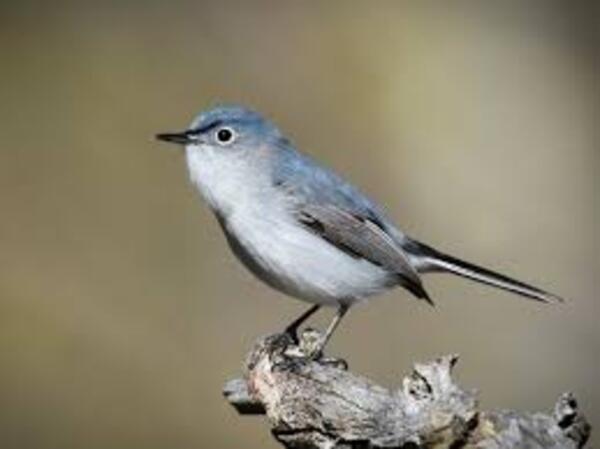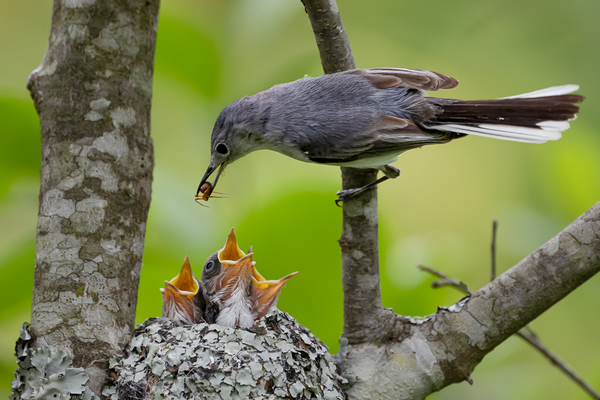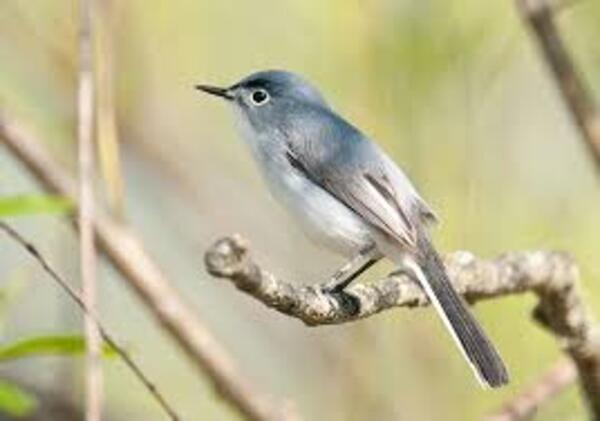The blue-gray gnatcatcher (Polioptila caerulea) is a small, energetic songbird that belongs to the family Polioptilidae. Despite its diminutive size, this bird is known for its lively behavior, striking appearance, and its important role in the ecosystem. In this article, we’ll explore everything you need to know about the blue-gray gnatcatcher, including its physical characteristics, behavior, habitat, and conservation status.
The blue-gray gnatcatcher is a tiny bird that is part of the family Polioptilidae. It is easily recognizable due to its vibrant blue-gray feathers, long tail, and active foraging behavior. These birds are often found flitting through the branches of trees, searching for insects and spiders to feed on.
Size: The blue-gray gnatcatcher is a small bird, measuring only about 4.5 to 5 inches (11-13 cm) in length.
Coloration: It has a soft blue-gray back and head, with a pale underbelly. The tail is long and dark, often held cocked upward.
Behavior: These birds are constantly on the move, often foraging in groups, and are very agile as they dart around the trees.

The Blue-gray gnatcatcher (Polioptila caerulea) is primarily considered a single species, but there are some variations within its range that can be distinguished by subtle differences in their physical traits and geographic distribution. While there aren't many distinct subspecies, the species has notable variations that can be grouped based on different regional populations.
Here’s a detailed overview of the Blue-gray Gnatcatcher and its subspecies, if applicable, including some key differences between them.
| Subspecies/Population | Scientific Name | Geographical Range | Physical Features | Behavior/Notes |
|---|---|---|---|---|
| Nominate Subspecies | Polioptila caerulea caerulea | Eastern and Central North America (from Southern USA to Mexico) | Blue-gray back and head, pale underparts, dark tail, active behavior | The most common form found in the eastern and central US; migratory. |
| Mexican Subspecies | Polioptila caerulea mexicana | Mexico (primarily in the southern regions) | Slightly darker coloration with a more pronounced dark tail | Typically found in more arid environments, migratory to Central America. |
| California Subspecies | Polioptila caerulea californica | California and surrounding areas | Generally lighter and smaller than other populations | Resident populations in California, non-migratory in some areas. |
Geographical Range: This is the most widespread and common subspecies, found throughout the eastern and central parts of the United States and into parts of Mexico.
Physical Features: The blue-gray gnatcatcher in this subspecies has the characteristic soft blue-gray back, pale underparts, and a long dark tail. It is known for its agility and fast movement as it flits around trees and shrubs searching for insects.
Behavior and Notes: This subspecies is highly migratory, traveling to southern regions of North America or Central America during the winter months and returning north in the spring to breed. They are commonly found in wooded areas, woodland edges, and shrubby environments.
Geographical Range: This subspecies is found primarily in Mexico, with populations in the southern parts of the country and extending into some Central American regions.
Physical Features: The Mexican subspecies is slightly darker in coloration compared to the nominate form, particularly in the tail, which tends to be more pronounced and darker.
Behavior and Notes: This subspecies tends to live in more arid, scrubby areas and may be more adapted to dry environments. It also migrates, but to a lesser extent, and is typically found in regions with fewer deciduous forests.
Geographical Range: Found mainly in California and parts of the southwestern United States. This subspecies has been noted in parts of Arizona and Nevada as well.
Physical Features: The California subspecies tends to be lighter in color than its counterparts. It also has a slightly smaller build.
Behavior and Notes: While many blue-gray gnatcatchers are migratory, the California population is somewhat resident, staying year-round in suitable habitats. The California gnatcatcher is especially well adapted to arid and semi-arid landscapes.
While these subspecies are generally quite similar in behavior and diet, their geographical location and subtle physical characteristics help ornithologists distinguish them.
Physical Coloration: The Mexican subspecies has a darker tail and slightly more pronounced coloration compared to the nominate subspecies, which is more blue-gray in overall tone.
Size: The California subspecies tends to be slightly smaller and lighter in appearance than the other two, likely a result of adaptations to the harsher, drier environments it inhabits.
Migratory Behavior: The nominate subspecies is more migratory than the California subspecies, which may remain in the same region year-round, especially in southern California.
The Blue-gray Gnatcatcher is primarily one species but shows some geographical variation, especially between populations in North America and Mexico. Despite these variations, all subspecies share similar behaviors, such as insectivorous diets, active foraging, and complex migratory patterns. Understanding these subspecies helps in studying their distribution and ecological roles within their habitats. Whether you observe them in forests of the east or deserts of the west, blue-gray gnatcatchers are a dynamic and essential part of their environments.
The blue-gray gnatcatcher is found primarily in North America, with its range extending from the southern United States to parts of Central America. These birds typically inhabit forests, woodland edges, and brushy areas, particularly those near water sources.
Woodlands and Forest Edges: Blue-gray gnatcatchers prefer deciduous forests, but they can also be found in pine forests and mixed woodlands. They are commonly seen in areas with dense undergrowth and shrubs, where they can easily forage for insects.
Migration: The blue-gray gnatcatcher is a migratory bird. In the fall, it migrates to southern regions of the United States or to Central America for the winter, returning north in spring to breed.
As their name suggests, blue-gray gnatcatchers primarily feed on insects, with a special preference for gnats, which are small flying insects. However, they also eat a variety of other small insects, spiders, and even some berries during the winter months when insects are less abundant.
Active Foragers: Blue-gray gnatcatchers are very active in their feeding habits. They dart around the branches of trees, often hanging upside down or hovering, as they search for food. Their small size and agility allow them to pick insects from tiny crevices and leaves.
Insectivorous Diet: They are insectivores, meaning that most of their diet consists of small invertebrates like flies, ants, and beetles. In winter, when insects are scarce, they may also consume berries and seeds.
The breeding season for blue-gray gnatcatchers typically occurs in the spring. These birds are known for their elaborate and well-constructed nests, which are built primarily by the female.

Nests: Blue-gray gnatcatchers build cup-shaped nests made of twigs, moss, spider silk, and other plant materials. The nests are usually located in shrubs or the lower branches of trees, often in a dense, sheltered area.
Eggs: The female typically lays 3 to 4 eggs, which are pale with small speckles. Both parents are involved in feeding the young after they hatch, although the female does most of the incubation.
Blue-gray gnatcatchers are often seen in small groups, especially during migration or the non-breeding season. These birds are highly active and social, communicating through various calls and songs.
Foraging in Groups: During the winter months, blue-gray gnatcatchers often form loose groups to forage together. These groups can include both males and females, and they work together to search for food in the trees.
Vocalizations: Their calls are high-pitched and can include a variety of chirps and whistles. Their song, which is a series of high-pitched notes, is often heard during the breeding season.
The blue-gray gnatcatcher is not currently listed as endangered or threatened, but its population can fluctuate depending on environmental conditions. Habitat loss, particularly deforestation and urban development, poses a threat to their preferred woodland habitats. However, they are still relatively common in their range and are not considered to be at immediate risk.
Habitat Destruction: Deforestation, urban sprawl, and agricultural expansion can lead to a loss of the trees and shrubs that the blue-gray gnatcatcher needs for foraging and nesting.
Climate Change: Changes in temperature and weather patterns can impact the availability of insects and other food sources, which could affect the gnatcatcher's migration patterns and overall survival.

The Blue-gray gnatcatcher (Polioptila caerulea) plays an important role in its ecosystem, particularly in insect control and plant pollination. As with all species, it also has natural predators that can affect its survival. Below, we will explore the predators of the Blue-gray gnatcatcher and the ecological role it plays in its habitat.
As a small, agile bird, the Blue-gray gnatcatcher has a variety of natural predators, including both avian and terrestrial creatures. Despite its ability to fly and evade danger, it faces threats throughout its life cycle, particularly during nesting and when young birds are vulnerable.
Raptors (Birds of Prey)
Hawks: Birds of prey, particularly hawks such as the Cooper’s Hawk (Accipiter cooperii) and Sharp-shinned Hawk (Accipiter striatus), are major threats to small songbirds like the Blue-gray gnatcatcher. These hawks are skilled hunters and can catch smaller birds in flight or while perched.
Eagles: Though less common, some species of eagles may also pose a threat, particularly in areas where the gnatcatchers inhabit taller trees or open landscapes.
Owls: Owls, especially nocturnal species like the Barn Owl (Tyto alba), may prey on the gnatcatcher during the night. Owls have excellent vision in low light and can easily detect smaller birds roosting in trees.
Snakes
Some species of snakes, including tree-dwelling and ground-dwelling types like the Eastern Rat Snake (Pantherophis alleghaniensis) or the Garter Snake (Thamnophis sirtalis), pose a risk to gnatcatchers, especially when they are nesting or on the ground. These snakes may target the eggs, chicks, or even adult birds.
Small Mammals
Squirrels: Squirrels, while not always predators, may sometimes raid the nests of small birds. They can steal eggs or even young chicks from the nests if they come across them.
Raccoons: In forested areas, raccoons may scavenge bird nests for eggs and young chicks.
Other Birds
Crows: Crows are opportunistic feeders and may attack smaller birds or raid nests for eggs. Their intelligence and social structure often make them a significant threat to smaller species like the Blue-gray gnatcatcher.
Starlings: European Starlings (Sturnus vulgaris) are known to compete aggressively for nesting sites and may displace Blue-gray gnatcatchers from their chosen locations.
Predatory Insects
While insects are not direct predators, certain predatory insects such as praying mantises or dragonflies may pose a threat to the young, especially when they are still developing in the nest.
The Blue-gray gnatcatcher plays a significant role in maintaining ecological balance. As an insectivorous bird, it has both direct and indirect effects on its environment. Here's a breakdown of its ecological importance:
Diet: The Blue-gray gnatcatcher primarily feeds on insects, particularly small flying insects like gnats, moths, beetles, and spiders. By consuming these insects, it helps to control pest populations in the areas where it lives. Insects such as mosquitoes and flies can be nuisances to both humans and wildlife, and the gnatcatcher plays a natural role in keeping these numbers in check.
Insectivorous Feeding: The gnatcatcher’s feeding habits help maintain a healthy balance in local ecosystems by limiting the population of various insect species. This not only benefits plants by reducing herbivorous insect populations but also helps prevent the overpopulation of pests that could damage crops or other wildlife.
While the Blue-gray gnatcatcher is primarily insectivorous, it can also play a minor role in pollination. As it flits through trees and shrubs in search of insects, it may inadvertently transfer pollen from one plant to another, especially in the case of flowers that are in close proximity to its foraging areas.
This role is not as prominent as that of bees or butterflies, but it can still contribute to the reproductive cycles of certain plants, helping to maintain biodiversity in the environment.
In addition to its insectivorous diet, the Blue-gray gnatcatcher may sometimes consume small fruits, berries, or seeds. By doing so, it could contribute to the dispersal of seeds across its range. As the bird moves from one area to another, it might drop seeds in different locations, which could help in the spread of plant species.
The Blue-gray gnatcatcher builds its nests in shrubs and trees, often in forested areas or along woodland edges. Its presence in these environments can influence the structure of plant communities. The nests, made from twigs, grass, and spider webs, can also provide microhabitats for small invertebrates.
Additionally, the gnatcatcher’s activity and behavior help to shape the ecological interactions in its territory, influencing which species of plants and animals thrive in the area.
Because of its sensitivity to habitat changes, the Blue-gray gnatcatcher is often considered an indicator species. A decline in its population may signal a disruption in the local ecosystem, such as habitat loss or environmental degradation. This makes the gnatcatcher an important species for conservationists who monitor the health of bird populations and natural habitats.
The Blue-gray gnatcatcher is an important species in its ecosystem, with natural predators and a vital ecological role. Although it faces threats from raptors, snakes, and other predators, it continues to play a significant part in controlling insect populations, aiding in plant pollination, and helping in seed dispersal. Additionally, as an indicator species, it provides valuable insight into the health of the ecosystem. By understanding its role and the challenges it faces, we can better appreciate the importance of preserving its natural habitats.
Energy Levels: Blue-gray gnatcatchers are extremely energetic and rarely sit still. They are constantly foraging and moving from branch to branch, making them hard to spot but easy to hear.
Migratory Patterns: These birds are one of the smaller songbirds that migrate long distances, traveling thousands of miles between their breeding and wintering grounds.
Agility: Their ability to hover in mid-air and dart through the branches of trees makes them some of the most agile birds in North America.
If you’re looking to spot a blue-gray gnatcatcher, here are some tips:
Look for Movement: These birds are rarely still, so keep an eye out for rapid movement in trees or shrubs. They often dart around or hover in search of food.
Listen for Their Calls: The blue-gray gnatcatcher has a high-pitched, chattering call that is easy to recognize.
Habitats: Look for them in woodland edges, forests, and shrublands, especially near water sources like streams and rivers.
The blue-gray gnatcatcher may be small in size, but it plays a crucial role in the ecosystem by controlling insect populations. Its energetic foraging habits, striking appearance, and migratory patterns make it a fascinating bird to observe. While not currently at risk, it is important to continue efforts to protect their habitats to ensure that future generations of this lively bird can thrive. Whether you're a birdwatching enthusiast or simply curious about wildlife, the blue-gray gnatcatcher is a wonderful species to learn about and appreciate.
animal tags: blue-gray-gnatcatcher
We created this article in conjunction with AI technology, then made sure it was fact-checked and edited by a Animals Top editor.